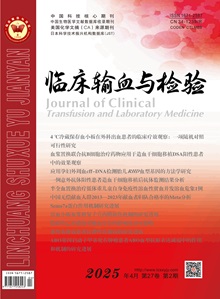|
|
0.01 mol/L DTT Treatment of Accidental Antibody Screening Reagent Erythrocytes to Eliminate Daratumumab Interference and its Clinical Adaptability
HE Xi-rong, ZHANG Fan, WANG Na, et al
JOURNAL OF CLINICAL TRANSFUSION AND LABORATORY MEDICINE
2022, 24 (6):
749-753.
DOI: 10.3969/j.issn.1671-2587.2022.06.013
Objective To investigate the effectiveness of reagents and assays suitable for screening tests for accidental antibodies to the red blood cell blood group system in daratumumab-treated patients.
Methods Red blood group antibody screening cells were treated with 0.2 mol/L dithiothreitol(DTT) and 0.01 mol/L DTT,and the plasma of 13 patients treated with darettuzumab was accidentally screened for antibodies using the treated reagent red blood cells(microcolumn gel method). The hemolysis degree,antigenicity of blood group antigen and red blood cell count were measured after treatment.
Results Both concentrations of reagent red blood cells were uniformly detected. Negative results from the unexpected antibody screening test were observed in 11 patients,and unexpected antibodies(anti-E)in 2. Hemolysis occurred in 0.2 mol/L DTT treated reagent red blood cells on the 5th day of storage at 4℃,while there was no hemolysis within 31 days after treatment with 0.01 mol/L DTT,and red blood cell count was not statistically different from that of untreated reagent cells(P=0.59,0.40,0.78,all greater than 0.05). The agglutination intensity of erythrocytes D,Fy
a,Fy
b,M,N,C,c,E,e,JK
a,JK
b,Le
a,Le
b,P1 and S antigens remained unchanged, but the agglutination intensity of K and k antigens was reduced.
Conclusion After 0.01 mol/L DTT treatment,RBC blood group antibody screening cells could be used to detect unexpected antibodies in the RBC blood group system of patients receiving darettuzumab treatment,effectively eliminate the interference of darettuzumab and identify alloantibodies. Moreover,long-term storage can be achieved at 4℃,which does not necessitate temporary treatment of reagent red blood cells, thus saving the test time.
Reference |
Related Articles |
Metrics
|
|
